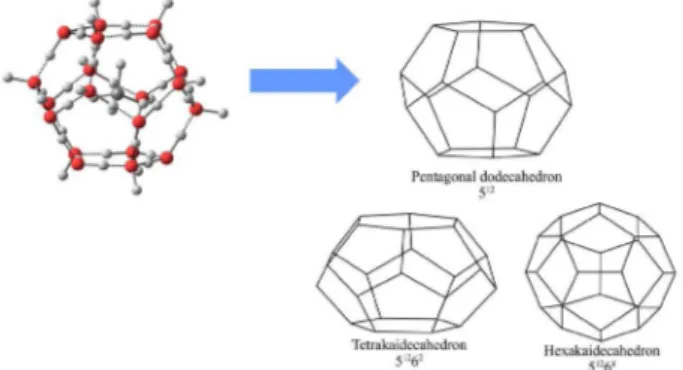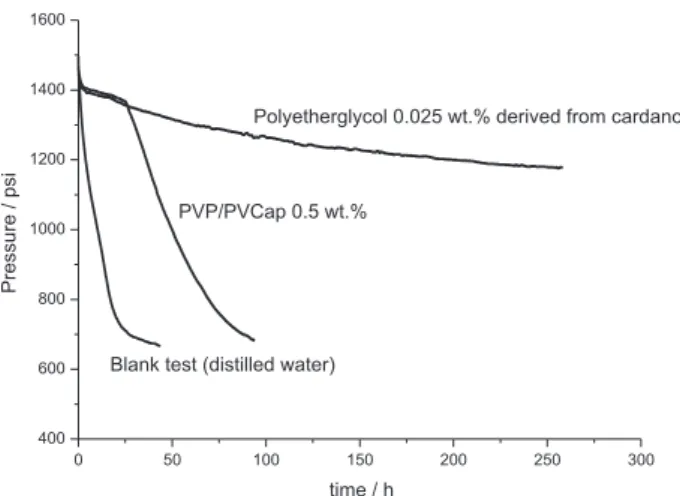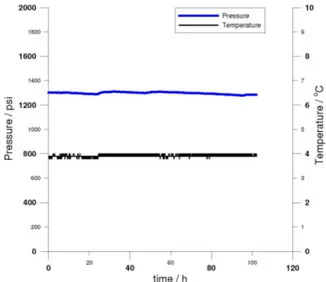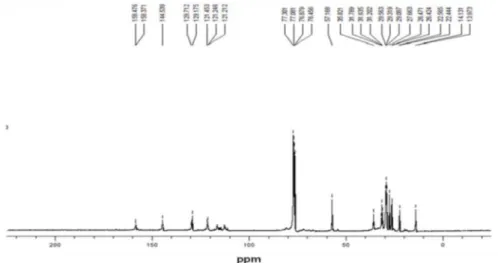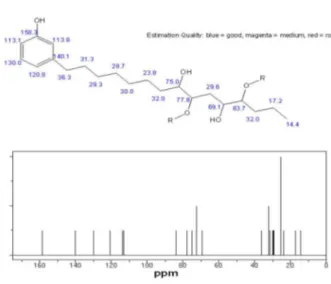Communication
J. Braz. Chem. Soc., Vol. 23, No. 1, 11-13, 2012. Printed in Brazil - ©2012 Sociedade Brasileira de Química 0103 - 5053 $6.00+0.00
*e-mail: pesteves@iq.ufrj.br
A Polyether Glycol Derived from Cashew Nutshell as a Kinetic Inhibitor for
Methane Hydrate Formation
Jorge Cesar Ferreira,a Adriana Teixeiraa,b and Pierre M. Esteves*,a
aInstituto de Química, Universidade Federal do Rio de Janeiro, CP 68545,
21945-970 Rio de Janeiro-RJ, Brazil
bCentro de Pesquisa e Desenvolvimento Leopoldo Américo Miguez de Mello, PETROBRAS,
Av. Horácio Macedo No. 950, 21941-915 Rio de Janeiro-RJ, Brazil
O polieterglicol derivado do líquido da casca da castanha do caju (CNSL) inibiu a formação de hidrato de metano. O polímero mostrou-se mais eficiente que o copolímero poli(vinilpirrolidona)-poli-(N-vinilcaprolactama)(PVP-PVCap) nas condições testadas (CH4, 1470 psi e 4 °C), sendo
esse último um dos melhores inibidores de hidratos comercialmente disponíveis.
The polyether glycol derived from cashew nutshell liquid (CNSL) inhibited the formation of methane hydrate. The polymer proved to be more efficient than the polyvinyl pyrrolidone-poly(N-vinyl) caprolactam (PVP-PVCap) co-polymer under tested conditions (CH4, 1470 psi and
4 °C), being the latter one of the best commercially available hydrate inhibitors.
Keywords: methane hydrate, flow assurance, kinetic inhibitor
Introduction
Clathrates of natural gas have been studied since 1890 when the first guest-host system was discovered.1-3 Hydrate
structures I (SI) and II (SII) formed by the building blocks (Figure 1), frequently occur and are formed by methane or natural gas. The formation of such clathrates represents a problem for the oil and gas industry since the plug formation of hydrate crystals can reduce or even interrupt the production.
Alcohol solutions with 10-60 wt.% are often used as thermodynamic inhibitors of such clathrates and about 500,000,000 US dollars are annually spent on hydrate prevention and flow assurance. Methanol and ethanol are the most frequently used alcohols for such goal.2 Another
class of hydrate inhibitors is the low dosage hydrate inhibitors (LDHI). Polymers as polyvinyl pyrrolidone
(PVP) and poly(N-vinyl) caprolactam (PVCap) have been
applied as kinetic hydrate inhibitors.
Cashew nut is a fruit from a native Brazilian tree. The liquids obtained from the nut processing for feeding are by-products and are mostly waste material.4 The cashew
nutshell liquid is found in mesocarp spongy (Figure 2).4
Cardanols are decarboxylated derivatives obtained by thermal decomposition of any naturally occurring anacardic Figure 1. Different cavities of hydrate crystal structures: structure I
(SI) contains 512 and 51262 cavities and structure II (SII) contains 512 and
51264 cavities. On the top left side, a whole atom representation of the 512
cavity is shown.
A Polyether Glycol Derived from Cashew Nutshell as a Kinetic Inhibitor J. Braz. Chem. Soc. 12
acids, which are the major components present in the cashew nutshell oil (Figure 3).
A chemical modification in a side chain of the cardanol produces a highly soluble polyether glycol in water (Figure 4).5 Due to the high water solubility of this
polymer and its easy availability in our laboratory, we have decided to evaluate it for the inhibition of gas hydrate formation, and our results are presented below.
Experimental
The polymer obtained from cardanol and used in this work was prepared according to a procedure previously described.5 Figure 4 briefly describes this procedure.5
PVP/PVCap co-polymer was used as received and was tested to evaluate the inhibition of hydrate formation. All tests were carried out in a 316 inox steel autoclave
produced by Autoclave Engineers (290 cm3 volume),
under pressures of 14.7 MPa (1470 psi). A preparation of a typical test run consisted of 200 cm3 of solution at low
polymer concentration (0.5 wt.% PVP/PVCap co-polymer, as recommended, or 0.025 wt.% to polyether glycol from cardanol prepared in distilled water). Then, the reactor was sealed and cooled at 277 K. The void volume was then purged with methane (99.99% purity from White Martins (Brazil), used as received) and the reactor was pressurized at 14.7 MPa. The system was stirred at 500 rpm6,7 with a
6-blade stirrer and was considered an NVT ensemble. Data acquisition for temperature and pressure was obtained at one-second intervals. Pressure decrease indicates that the
gas is being consumed due to methane hydrate formation,
i.e., CH4 + nH2O = CH4•(H2O)n (methane hydrate). These
experiments were carried out in triplicates (additional results in the Supplementary Information section, SI). Characterization of the polymer was made through 1H and
13C nuclear magnetic resonance (NMR) and infrared (IR)
spectroscopy.
Results and Discussion
Figure 5 shows the results for the cardanol derived polyether glycol solution and, to compare its performance, a commercial PVP/PVCap co-polymer was employed. Typical plots of pressure over time were observed, and can be compared with data from literature.8 The blank test
started to form hydrate from the very beginning, being discerned from the drop in the pressure. It is observed that for both polyether glycol and PVP/PVCap polymer cases, there is a small decrease in the pressure, which can be associated to methane solubilization and to growth of a small portion of hydrate, before eventual drastic hydrate formation. The PVP/PVCap co-polymer led to the catastrophic hydrate formation (see the drastic drop in gas pressure) after 27 h, about 1 day. On the other hand, the cashew nutshell derived polymer maintained the high pressure in the cell for several days, when the tests were interrupted (see results for triplicates of this experiment in the SI section). Figure 6 shows the methane consumption as a function of time.
The cardanol derived polyether glycol solution therefore reveals a better inhibitor behavior, delaying the catastrophic formation of the gas hydrate for a longer time, compared to the commercial PVP/PVCap co-polymer. This one retarded the methane catastrophic hydrate formation for only about 1 day. The impressive performance of the cashew nutshell liquid derived polymer from renewable resource (biomass) and its low cost (ca. 1.00 US dollar per g of pure polymer, using research grade reactants, equivalent to 0.25 US dollar per L of solution 0.025 wt.%) should make it an attractive option for methane hydrate inhibition in Figure 3. Structure of the anacardic acids and cardanol present in cashew
nutshell liquid where n = 0, 2, 4, 6.
Ferreira et al. 13 Vol. 23, No. 1, 2012
Figure 5. Inhibition performance of polyether glycol derived from cardanol compared with PVP/PVCap co-polymer and a blank test.
Figure 6. Consumption of methane gas using solution of polyether glycol derived from cardanol compared with PVP/PVCap co-polymer solution and a blank test (distilled water).
the oil industry. Further studies in this direction are being carried out in our laboratory.
Conclusions
We showed that this polymer derived from cashew nutshell oil works as an inhibitor of the catastrophic methane hydrate formation, being more efficient (under the present experimental conditions: CH4, 1470 psi and
4 oC) than the commercial PVP-PVCap co-polymer.
This polymer derived from biomass can be used as an option for commercial inhibitors with advantages for oil exploitation and flow assurance.
Supplementary Information
Data concerning the triplicates of the inhibition experiments with the polyether glycol and blank tests, IR and 1H and 13C NMR characterizations of the polymer,
together with simulated 1H and 13C spectra of the monomer,
are available free of charge at http://jbcs.sbq.org.br as pdf file.
Acknowledgements
The authors thank to Conselho Nacional de Desenvolvimento Científico e Tecnológico (CNPq), Coordenação de Aperfeiçoamento de Pessoal de Nível Superior (CAPES) and Fundação de Amparo à Pesquisa do Estado do Rio de Janeiro (FAPERJ) by the financial support, and Prof. Simon J. Garden for helpful discussion.
References
1. Lederhos, J. P.; Long, J. P.; Sum, A.; Christiansen, R. L.; Sloan Jr., E. D.; Chem. Eng. Sci. 1996, 51,1221.
2. Ripmeester, J. A.; Ratcliffe, C. I.; J. Phys. Chem. 1990, 94, 8773.
3. Sloan, E. D.; Koh, C. A.; Clathrate Hydrates of NaturalGases, 3rd ed.; CRC Press: New York,2008.
4. Soares, J. B.; O Caju Aspectos Tecnológicos;Banco do Nordeste do Brasil: Fortaleza, CE, Brasil, 1986.
5. Ferreira, J. C.; Visconte, Y. L. L.; Guimarães, P. I. C.; BrPI 0403145-8,2004
6. Natajaran, V.; Bishinoi, P. R.; Kalogerakis, N.; Chem. Eng. Sci.
1994, 49, 2075.
7. Vysniauskas, A.; Bishnoi, P. R.; Chem. Eng. Sci. 1983, 38, 1061. 8. Yang, J.; Tohidi, B.; Chem. Eng. Sci. 2011, 66, 278.
Submitted: July 21, 2011
Supplementary Information
S
I
J. Braz. Chem. Soc., Vol. 23, No. 1, S1-S3, 2012. Printed in Brazil - ©2012 Sociedade Brasileira de Química 0103 - 5053 $6.00+0.00
*e-mail: pesteves@iq.ufrj.br
A Polyether glycol Derived from Cashew Nutshell as a Kinetic Inhibitor for
Methane Hydrate Formation
Jorge Cesar Ferreira,a Adriana Teixeiraa,b and Pierre M. Esteves*,a
aInstituto de Química, Universidade Federal do Rio de Janeiro, CP 68545,
21945-970 Rio de Janeiro-RJ, Brazil
bCentro de Pesquisa e Desenvolvimento Leopoldo Américo Miguez de Mello, PETROBRAS,
Av. Horácio Macedo No. 950, 21941-915 Rio de Janeiro-RJ, Brazil
Figure S1. Pressure variation on methane hydrate formation tests using distilled water (blank test in triplicate).
Figure S2. First repetition of the experiment of polyether glycol shown in Figure 5. Pressure (purple) and temperature (blue) are shown.
Figure S3. Second repetition of the experiment of polyether glycol shown in Figure 5. Pressure (blue) and temperature (black) are shown.
A Polyether glycol Derived from Cashew Nutshell as a Kinetic Inhibitor J. Braz. Chem. Soc. S2
Ferreira et al. S3 Vol. 23, No. 1, 2012
Figure S8. Simulated 1H NMR of the monomer obtained using the ChemDraw® Ultra version 8.0 from Cambridge Software Co.
